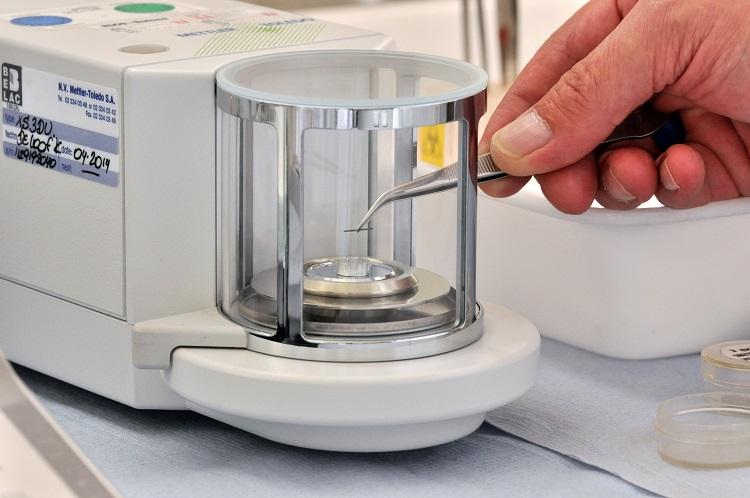Dosimétrie de réacteur
-
The RPV (Reactor Pressure Vessel) of a nuclear reactor is a key issue in its safety assessment. This vessel is a primary loop barrier and contains the nuclear fuel. During reactor operation the RPV is subject to severe conditions (gamma and neutron radiation, temperature gradients), which gradually degrades the vessel.
The main damaging mechanism is the material embrittlement due to its exposure to (fast) neutrons. The embrittlement of the RPV is the limiting factor for the lifetime of the reactor. Therefore all modern nuclear reactors are equipped with a set of RPV surveillance capsules containing representative steel specimens (to investigate the material degradation) and neutron dosimeters (to determine the neutron exposure responsible for the degradation). The capsules are introduced close to the RPV before the reactor start and dismantled and analysed on a regular basis during its lifetime.
Reactor dosimetry thus aims at determining the neutron fluences that were present at the RPV during the reactor operational lifetime. This information can be obtained from the measured activity of the irradiated neutron dosimeters and the detailed RPV irradiation history (including neutron spectrum calculations).
An important activity in the field of reactor safety is the irradiation of materials. For existing reactors with an inadequate RPV surveillance programme so-called advanced material testing irradiations in high-flux reactors are sometimes required. Also, new types of material or nuclear instrumentation need to be tested in high neutron fluxes for its possible application in next generation reactors. Although neutronic calculations are mostly performed for such experiments, they should always be equipped with neutron dosimeters for an accurate determination of the neutron flux or fluence (time integrated flux).

Neutron reactor dosimetry services
The Nuclear Systems Measurements unit provides neutron reactor dosimetry services. This includes following activities:
- Determination of the neutron induced gamma- (or X-ray) activity of dosimeters or samples.
- Determination of the neutron flux and fluence at the dosimeter or sample position.
- Design and composition of neutron dosimetry sets for experiments and for reactor pressure vessel surveillance programmes.
- Irradiations in neutron standard fields in the BR1 reactor.
- Consultancy and services for retrospective reactor dosimetry and for research and reactor experiments.
SCK CEN and the reactor dosimetry group in particular is actively involved in the European Working Group on Reactor Dosimetry.
Our infrastructure
The reactor dosimetry laboratory is equipped with six hyper-pure germanium detectors at which sample activities ranging from 102 Bq up to 108 Bq can be measured. One of these systems is exclusively used for the detection of X-rays.
In order to increase the laboratory efficiency, a fully automated detection system has been developed. This is a stand-alone system operated with in-house developed, validated software and has a sample changer in which up to thirty dosimeters can be loaded.
The measurement data are converted to activities, neutron fluxes and fluences using Excel worksheets and in-house developed software taking into account irradiation history and material burn-up corrections.
In addition to the six germanium detectors, the laboratory is equipped with:
- a glove box
- a fume hood
- precision balances
- a separate dosimeter preparation and weighing room
Accreditation
Thanks to the many R&D activities and services offered by it for many years already, SCK CEN has comprehensive experience in the field of reactor dosimetry. The reactor dosimetry laboratory received its first accreditation in 1998.
Today, SCK CEN's reactor dosimetry services has been accredited by BELAC (Ministry of Economic Affairs) under the accreditation number 015-TEST, norms NBN EN ISO/IEC 17025, for the following measurements:
Standard tests
- ASTM E181
-
Standard Test Methods for Detector Calibration and Analysis of Radionuclides
-
- ASTM E261
-
Standard Practice for Determining Neutron Fluence Rate, Fluence, and Spectra by Radioactivation Techniques
-
- ASTM E262
-
Standard Test Method for Determining Thermal Neutron Reaction and Fluence Rates by Radioactivation Techniques
-
- ASTM E263
-
Standard Test Methods for Measuring Fast-Neutron Reaction Rates by Radioactivation of Iron
-
- ASTM E264
-
Standard Test Methods for Measuring Fast-Neutron Reaction Rates by Radioactivation of Nickel
-
- ASTM E523
-
Standard Test Methods for Measuring Fast-Neutron Reaction Rates by Radioactivation of Copper
-
- ASTM E526
-
Standard Test Methods for Measuring Fast-Neutron Reaction Rates by Radioactivation of Titanium
-
- ASTM E704
-
Standard Test Methods for Measuring Reaction Rates by Radioactivation of Uranium-238
-
- ASTM E705
-
Standard Test Methods for Measuring Reaction Rates by Radioactivation of Neptunium-237
-
- ASTM E1005
-
Standard Test Method for Application and Analysis of Radiometric Monitors for Reactor Vessel Surveillance
-
- ASTM E1297
-
Standard Test Methods for Measuring Fast-Neutron Reaction Rates by Radioactivation of Niobium
-